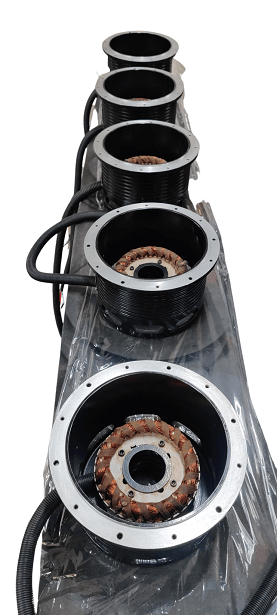24V Alternator Manufacturer
Innotec provides 24V Alternators and 24V generators in its flywheel – engine mounted generator line (see product line here), belt driven units (see product line here) and standard shaft based units.
Most of these units are designed to work with an engine’s rpm (revolution per minute – the speed at which the engine is turning its output shaft) or a ratio of the rpm through a belt drive.
Innotec’s 24V generators and 24V alternators are compact, customizable to match engine’s drive inputs and have a wide range of power outputs available.
Innotec’s standard 24V units go up to 600 amp outputs.
Contact Us to Discuss your exact requirements
Why 24V DC and its uses?
- Lots of sensors, instruments, and other control devices can be powered by a 24V DC supply.
- Relays have been powered by 24VDC in industry, and this practice continues with PLCs and computer-control
- Motor control on 24Vdc is becoming more common and available
- 24V DC is a standard that can be used globally, creating a universal voltage source compared to AC equivalents
- Early industry adopters for mobile technology included military, aviation and trucks.
RPM for 24V systems
In an auxiliary power system, there is more control on the RPM because the primary purpose of the generator may be for 24V output. For other applications, the need for voltage regulation becomes harder with a wider speed range.
Typical rpms, for an on-highway engine will vary. The size, number of cylinders, engine fabrication, and type of transmission will determine typical engine RPM ranges. An 8-cylinder engine will frequently operate between 700 RPM and a max of 6,000 RPM, while a 4-cylinder engine will typically run between 700 RPM and 7,000 RPM. This will largely depend on the use case. In most use cases, the rpm range is narrower but in accounting for the operating rpms for the 24V alternator, there needs to be pre-caution by taking in consideration the possible range of input rpms.
24V Alternator Regulator
This affects the system design and the voltage regulation of the 24v generator. Adding a buck converter can greatly improve efficiency of the total hybrid drive and help when there is consistent electric load. The most used DC/DC converter topology in switching regulators is the buck converter. It is a straightforward technique that efficiently regulates the output voltage while stepping down the input voltage to a lower voltage level.
24V Generator Battery Systems
While charging deep-cycle flooded, regular flooded, gel, AGM, Lithium batteries, it can deliver even more efficiency.
It is crucial to ascertain the capacity your charging system is capable of supporting in order to get the best performance possible from it. In general, the acceptance rate of the batteries being charged should be reflected in the size rating of the alternator. The rates of charging of various battery technologies will differ (the max/ideal charging amps % of total battery capacity). A deep cycle flooded battery, for instance, may normally absorb about 25% of its total capacity at any given moment. Therefore, we need our alternator’s rated output to match the battery’s acceptance rate when it hits its maximum discharge rate. In other words, a 400 amp-hour deep cycle flooded battery would need an alternator with a 25 percent rating of that capacity (100 AMP). This can also be achieved with a good current regulator.

